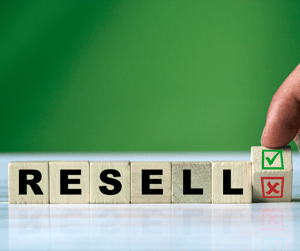When your company's products are sold, you expect to be able to make a profit on them. You don’t expect to see their unauthorized sales, and you don’t want to see your brand’s integrity jeopardized.
Yet that’s exactly what can happen if your products end up on the grey market.
What Is the grey market? The grey market refers to the trade of genuine goods through unauthorized distribution channels, often involving the resale of products outside of the manufacturer's intended distribution network or across different geographic regions without the manufacturer's consent.
Goods or packaging can end up on the grey market through various means, from unauthorized distribution by retailers or wholesalers to even theft and counterfeiting. Many of these products are expired, bad batches or knock-off products being sold in legitimate branded packaging.
When your company’s products are sold this way, not only are you losing money, but your reputation may be seriously downgraded. You may even be at risk for litigation if the products are tainted, inferior or unsafe.
Here’s how to tell if your products are on the grey market, what to do next and how you can prevent your brand from ever being compromised in the first place.
Signs Your Products Are On The Grey Market
Detecting whether your products or packaging are being sold on the grey market can be challenging but there are several indicators you can look out for:
- Price Discrepancies: If you notice your products being sold significantly below the standard retail price or there's
 a vast difference in pricing across different markets or channels, it could be a sign of grey market activity.
a vast difference in pricing across different markets or channels, it could be a sign of grey market activity. - Unusual Distribution Channels: Keep an eye on where your products are being sold. If you find them in channels or regions where you haven't officially authorized their distribution, it could indicate grey market sales.
- Unauthorized Resellers: Check your authorized retailer list regularly and monitor for any unauthorized sellers cropping up. Grey market sellers often operate without your consent.
- Packaging Discrepancies: Look for differences in packaging such as labels, barcodes, or other identifying marks. Grey market products might have altered packaging or lack the usual quality control measures.
- Parallel Imports: If your products are intended for sale in one geographic region but you find them being sold in another region without your authorization, it could signal grey market activity.
- Lack of Manufacturer Warranty: Grey market products may not come with the manufacturer's warranty or support, which can be a red flag for consumers and retailers alike.
- Quality Concerns: Grey market products may not meet the same quality standards as those distributed through authorized channels. If you notice an influx of complaints about product quality, it's worth investigating the source.
- Consumer Feedback: Keep an eye on consumer feedback and reviews online. If customers are reporting issues with counterfeit or unauthorized products, it could be a sign of grey market sales.
- Investigate Suspicious Activity: Act on any reports or suspicions of grey market activity promptly. Conduct thorough investigations to identify the source and take appropriate action, which may include legal measures.
- Monitor Sales Channels: Regularly monitor sales data and channels to identify any irregular patterns or trends that could indicate grey market sales.
By staying vigilant and actively monitoring your distribution channels and product sales, you can better detect and address grey market activity to protect your brand and maintain control over your products.
What To Do If Your Products Are On The Grey Market
If you discover that your branding is being sold on the grey market, it's important to take immediate action to protect your brand reputation and regain control over your products. Here are some steps you can take:
- Investigate the Situation: Conduct a thorough investigation to determine the extent of the grey market activity. Identify the sources of unauthorized distribution and how your products are being sold.
- Cease Unauthorized Distribution: Contact the unauthorized sellers and demand that they cease selling your products immediately. Provide clear instructions on how they can return any remaining inventory to you.
- Legal Action: Consult with legal counsel to understand your options for taking legal action against grey market sellers. This may include sending cease and desist letters, pursuing injunctions, or filing lawsuits for trademark infringement or unauthorized distribution.
- Monitor and Enforce: Continuously monitor your distribution channels and online marketplaces for grey market activity. Take swift action against any unauthorized sellers or distributors to deter future violations.
- Work with Law Enforcement: If you suspect criminal activity or counterfeiting, report the grey market activity to relevant law enforcement authorities. Provide them with any evidence or information you have gathered during your investigation.
Unfortunately, once your products, packaging or branding ends up on the gray market, there’s not a lot you can do. In fact, in some cases, there may be no illegal activity taking place. For example, Sometimes, manufacturers or authorized distributors may sell off excess or outdated inventory to liquidators or clearance houses. These products may then find their way into the gray market, where they are resold at discounted prices. As long as the products are genuine and legally obtained, this resale may not be illegal.
However, the presence of unauthorized sellers can still erode brand trust and undermine your official distribution channels. That’s why taking proactive measures in the first place is critically important to protect your brand. Let’s take a look at what steps you can take to prevent grey market sales.
How To Prevent Grey Market Sales
The expression, “An ounce of prevention is worth a pound of cure,” is particularly important when it comes to preventing products from ending up on the grey market. Taking proactive measures to safeguard distribution channels, enforce authorized sales and educate stakeholders can save considerable resources and reputation damage down the line.
What can you do to protect your brand?
Engage with industry associations. Collaborate with industry associations and trade organizations to address grey market issues collectively. Share best practices and coordinate efforts to combat unauthorized distribution.
Protect distribution channels. Strengthen your authorized distribution network by implementing measures to prevent unauthorized sales, such as implementing selective distribution agreements, enforcing MAP (Minimum Advertised Price) policies, or utilizing technology solutions like brand protection software.
Educate consumers and retailers. Raise awareness among consumers and retailers about the risks associated with purchasing grey market products, including counterfeit goods, lack of manufacturer warranty and potential quality issues.
Prioritize how your products and packaging are disposed of. Certified product disposal can protect your brand and prevent products and packaging from falling into the hands of the grey market.
When companies decide to dispose of excess inventory, expired products or defective items, it's crucial to ensure that this process is conducted securely and responsibly to avoid potential risks associated with unauthorized resale or distribution.
By utilizing certified product disposal services, companies can guarantee that their products and packaging are handled in compliance with legal and environmental regulations. These disposal services involve the secure destruction or recycling of products and packaging materials to prevent them from re-entering the market through unauthorized channels.
Many industries can benefit from the use of certified product disposal, including:
- Pharmaceutical
- Electronics
- Food and beverage
- Fashion and apparel
- Automotive
- Cosmetics and personal care
- Healthcare
- Chemicals and hazardous materials
- Hospitality
- Construction and demolition
- Government and public sector
One of the primary benefits of certified product disposal is the assurance that the disposed items are rendered unusable and unfit for resale. Through methods such as shredding, crushing or incineration, products and packaging can be effectively destroyed, minimizing the likelihood of them ending up on the grey market. Certified product destruction services often provide documentation or certification to verify that the disposal process has been completed according to industry standards, offering companies peace of mind and legal protection.
By partnering with a reputable, certified product disposal company, you can effectively safeguard your products and packaging from the risks posed by the grey market while demonstrating your commitment to responsible business practices.



Comment